Chanthaburi Province in Eastern Thailand
Chanthaburi is located some 330 km east of Bangkok and one needs about 4 hours to get there from the capital. This is a long stretch for a one day trip, so we do not really recommend it. However, if you stay closer by (like Pattaya or Rayong) there are a few places of interest to visit around Chanthaburi town.
Chanthaburi at present is famed for its gems trade and fairs. Nowadays, most gems traded are actually imported to Thailand. Sapphires and rubies are prominent. The province is also renowned for its durian and other fruits and many fruit markets are in the vicinity of the town.
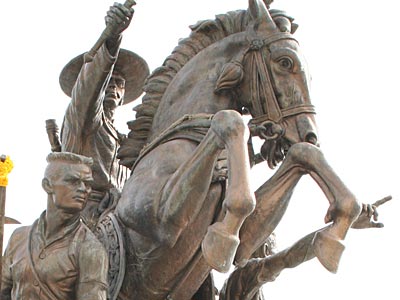
Statue of King Taksin (detail) at King Taksin park, Chanthaburi.
The historical background to the city is quite interesting. It is in Chanthaburi that King Taksin the Great, basically reassembled an army to drive the Burmese out of Ayutthaya and Thailand.
Ayutthaya (and the Kingdom of Ayutthaya) was sacked and looted by the Burmese in 1767. Phraya Taksin (the rules of Tak), a half-Chinese, half-Thai general wanted to come to the rescue of the city with his army, but realizing the situation was hopeless, he manage to escape the victorious Burmese army, and made his way down the the East all the way to Chanthaburi. He conquered Rayong, and then Chanthaburi, after famously ordering his troops to destroy all remaining food supplies, so that they had to take the city in order to eat. Phraya Tak used Chanthaburi as as base to gather more troops, weapons, supplies, and to build 100 fighting chips. After that he returned his force by river to Ayutthaya overcoming many small rebellious groups along the route including those at Chonburi and Thonburi. Finally Phraya tak led his force to attack the Burmese , drove them out and regained Ayutthaya. However, the once grand city of Ayutthaya, was utterly destroyed, and Taksin decided to make his capital further south, close to the entrance of the Chao Phraya into the sea, at Thonburi. He ruled his new kingdom from 1769 to 1782, until he was deposed by his ministers and executed.
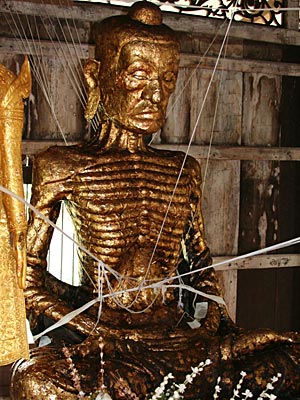
Buddha image showing Mortification, at the Assembly Hall of Wat Plab, Changkraja district, Chanthaburi.
From 1893 to 1905, Chanthaburi was actually occupied by the French. If you think about it, this is not all that long ago. The occupation of Chanthaburi is related to the infamous Paknam incident, when French war ships somehow managed to navigate up the Chao Phraya river, reached Bangkok, close to the Royal Palace. The incident occurred at the time the French colonial power was intended on expanding its territory. It is worth remembering that at the time the Kingdom of Siam controlled most of present day Laos, and the Western part of present day Cambodia. As a result of the Paknam incident (that occurred together with French troop movements into the eastern part of Thailand), the boundaries of Thailand were thoroughly modified. About one third of Thailand was ceded to the French (and never regained afterwards when the colonial power left South-East Asia).
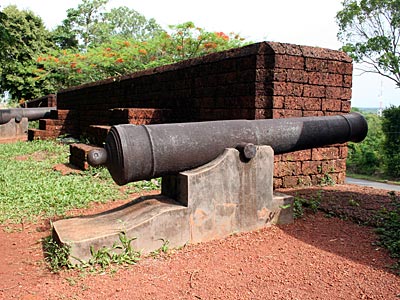
Cannons at Noen Wong Fortress. The National Maritime Museum is housed on the grounds of Noen Wong Fortress.
Noen Wong Fortress (National Maritime Museum)
During the reign of King Rama III of the early Bangkok period, Noen Wong Fortress was built as a defense position in the fight with the Vietnamese in 1834 A.D. The camp, which is surrounded by ramparts and moats, covers an area of 270 rais (43.20 hectares). The fortress is made of the bricks and contains 39 cannons, most of which still seem to be present. Inside the camp is an arsenal structure and a shrine housing the City Foundation Pillar. Noen Wong Fortress now houses the National Maritime Museum. There are models of likely all boats that were used in Thailand, as well as a full sized old transport ship on display. The Museum also gathers and displays artefacts (Sukhothai ceramics that were heavily traded in ancient days) found in sunken vessels. The Fine Arts Department is involved in Underwater Archaeology, recovering sunken vessels in the Golf of Thailand.

Cathedral of the Immaculate Conception at Chanthaburi. It was reconstructed many times, last in 1906.
Cathedral of the Immaculate Conception
Interestingly there is Cathedral in Chanthaburi (Cathedral of the Immaculate Conception). This cathedral was reconstucted on many occasions, to accommodate more and more Catholic worshippers. The last time this occurred in 1906. There is also a large community of catholics of Vietnamese descent in Chanthaburi. The cathedral is actually quite large, and pleasantly well maintained.
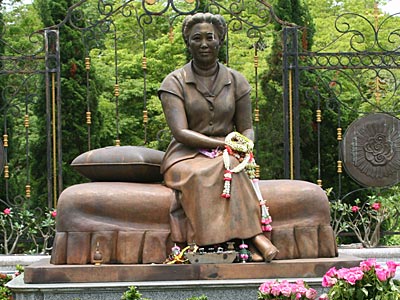
Statue of Queen Rambhai Bharni, at the Provincial Cultural Center.
If you are around you may also visit the Provincial Cultural Center, which was the summer palace of Queen Rambhai Bharni, in the reign of King Rama VII. The center exhibits her personal belongings as well as artifacts discovered in the province. The grounds, and living quarters make for a pleasant walk.
Wat Plab is in Changkraja district and houses a wooden assembly hall and a scripture repository placed above water. There is an interesting Buddha image in the posture of mortification. However, unfortunately, the surrounding area has somehow been transformed into some kind of market, and the racked created by this, is somewhat disconcerting.
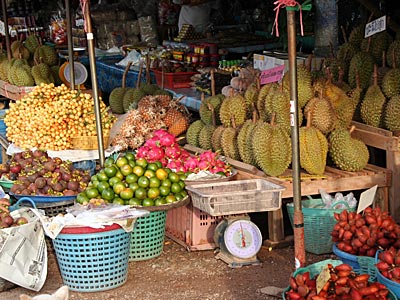
One of many fruitmarkets in and around Chanthaburi town.

